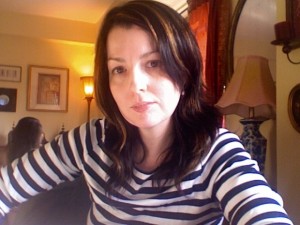
Celia Caro
CELIA CARO is a contemporary and teaching visual artist with an extensive background in working with students of all ages in schools and non-profit community arts organizations throughout New York City and State. Committed to fostering innovative and motivating approaches to student-centred art education with an emphasis on individual learning styles, creative problem-solving and social consciousness, the core of her teaching practice centres on inventive and collaborative art making, and includes a wide variety of visual media including bookmaking, puppetry, animation and sculpture. She holds a master’s degree in Art Education from Pratt Institute and was awarded the Outstanding Merit and Pratt Circle Awards upon her graduation with distinction in 2009. Celia’s personal work has been exhibited throughout the metropolitan area, most recently in the DUMBO Arts Festival. Visit her website: www.celiacaroarteducation.com
For those who may not know, Celia, what defines a “contemporary artist” and how would you describe your current work?
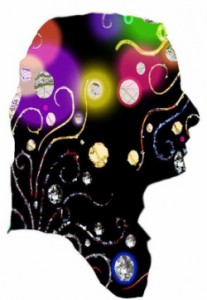 Well, for me a contemporary artist is an artist who is post-modern, in that they cross boundaries and disciplines. As a mixed media artist, I fuse illustration, collage, photography and digital art.
Well, for me a contemporary artist is an artist who is post-modern, in that they cross boundaries and disciplines. As a mixed media artist, I fuse illustration, collage, photography and digital art.
And what role do some or all of these media play in your new course for New York Public Library, “Drawing From Experience: A Graphic Memoir Workshop Series”?
In this workshop, I’m introducing students to the graphic memoir through drawing, collage and bookmaking. We’ll examine art and books created by graphic artists like Art Spiegelman
This is the first time I’ve taught it. The title “Drawing From Experience” actually came from Carlos Chavez, the librarian who I am running the workshop with. Carlos wanted to emphasize the wealth of experience older students bring with them. During a brainstorming meeting with Sharon Jarvis, the library branch manager, we were looking at my website when Sharon said, “What your work is really about is graphic memoir. What don’t we do that for the workshop?” That lit a fire in me and a course was born. So while I’m working on my memoir, the students will be working on theirs. I’m very excited. We have a lot of motivated artists and writers in the group. It’s new for me too, because I’m teaching art and writing together for the first time. We will have a supplemental reading and movie list, so students can check out materials from the library and learn more about Maus and Persepolis. I love working with libraries because they are so committed to providing free educational opportunities to the communities they serve.
I’ll get back to your memoir shortly, but first, how do you approach teaching art and writing at the same time to beginners?
I do a kind of feedback loop: art-writing-art. The first class I had them draw something that they had in their bag — a pocket comb, Metro card, lipstick — then I had them write about their feelings about that item or an experience they had with that item, and finally I had them make a mini-book using their story and featuring more drawings — so that they could begin to think in a visual and narrative sequence. One student picked his reading glasses. He created a poignant drawing of his rickety glasses and said how he both loved and hated them, hence their poor condition. He loved being able to read with them, but he hated needing them to see. When he told us how he was picked on at school for wearing glasses and said, “Kids can be so cruel,” the other students chimed in, “Yes they can!” and “So true.”
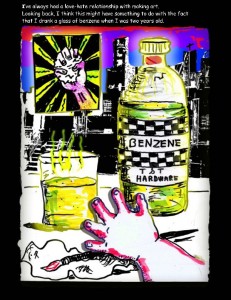 For the collage project, I left it up to them — writing first or art first. They all took those books to work on at home and they seemed very excited about having more privacy and time to do so. This project is more abstract and does not need a strict narrative structure. It’s more about emotions. For a future class I’m going to have them make a collage portrait of someone who is important to them on a postcard, and then have them write a message to that person on the back. This collage will go into their final book.
For the collage project, I left it up to them — writing first or art first. They all took those books to work on at home and they seemed very excited about having more privacy and time to do so. This project is more abstract and does not need a strict narrative structure. It’s more about emotions. For a future class I’m going to have them make a collage portrait of someone who is important to them on a postcard, and then have them write a message to that person on the back. This collage will go into their final book.
And what form does that final project take?
The last project will be accordion books that are 6 to 12 pages in length and will feature the student’s art and writing.
Back to your own work, I enjoyed your short personal video “My Life in Pictures.” How did it come about?
Thank you for the compliment. I have had such a positive response to that little film, which was actually made for a job interview at BRIC Arts Media for a teaching artist position. They requested that we show our personal work. I was tired of slide shows, so I wanted to make a little film about my process, which combines drawing and art. The film part was new, but I really enjoyed seeing my images and words move. I got the job, by the way.
My Life In Pictures from Celia Caro on Vimeo.
Congratulations, I’m not surprised! . . . Now, tell us more about the memoir you’re writing.
I’m not published (yet), but I am working on a graphic memoir about my life. The working title is “That’s Not Art.” I have some of the illustrations on my website and on the “That’s Not Art” Facebook page. I have finished the first part, which covers my childhood experiences with art. I have a love/hate relationship with art. My parents were young artists in the East Village, and it being the late 1960s, my early years were filled with all kinds of wild events like anti-war protests, happenings and even séances. I also drank the brush cleaner Benzene when I was two and ended up in Bellevue hospital for two weeks tied to a crib. So art is in my blood, but experiences like that made the bohemian life sometimes painful and overwhelming for me, so I escaped into my drawings. When I drew so-called “bourgeois” things like princesses, I was told by some of my parents’ colleagues that my drawings were not art. That planted the seeds of doubt in my mind.
Do you consider yourself a writer who creates art, or an artist who incorporates language into her art?
I am both a writer and artist. I really need to do both to communicate my ideas.
How much of your art is drawn from personal experience?
Most of my work is personal, but not always autobiographical. I can’t help but filter my personal experiences through my work. For instance, I have lived most of my life in New York City, so my work is like a city street, multilayered and packed with imagery.
You do bookmaking as well. How does this dovetail with your other artistic projects?
There is a big connection. I actually make handmade books to help me work through my ideas. I am very hands-on and I need to make a physical object in order to understand what I’m doing. Even if I later scan and digitally manipulate my work, I have to physically create it first. By combining the handmade and digital I feel that I’m integrating my emotions with my intellect.
Does the makeup of your new graphic memoir class differ from that of others you’ve taught?
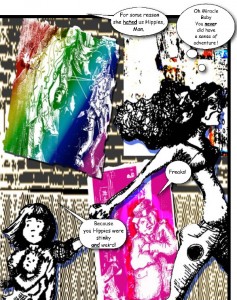 My other experiences have been with students who were very gung-ho to express their ideas with the group. This group has people from all kinds of ethnic and social backgrounds and the students do not know each other from the neighbourhood. Many have never written or made any art before, so they are more cautious. Plus we are talking about their lives, not flowers or landscapes, so it’s personal and that can make people feel very vulnerable and worried about being judged. I know I feel that way . . . so I respect their limits and privacy and just try to encourage them to make their process their own.
My other experiences have been with students who were very gung-ho to express their ideas with the group. This group has people from all kinds of ethnic and social backgrounds and the students do not know each other from the neighbourhood. Many have never written or made any art before, so they are more cautious. Plus we are talking about their lives, not flowers or landscapes, so it’s personal and that can make people feel very vulnerable and worried about being judged. I know I feel that way . . . so I respect their limits and privacy and just try to encourage them to make their process their own.
How is it going so far?
What’s interesting for me is how my students are already claiming the course for themselves, asking for reference materials, writing poetry and making suggestions about what they’d like to learn more about. However, I am surprised that they are shy about sharing their work. They often ask me to read their stories to the class instead of doing it themselves, but they may become more willing to express themselves as a sense of trust grows in the class. I did a collage mini-book project about memories with them during one class and they enjoyed that — collage is a great medium for students who don’t have a lot of art education — ready-made imagery.
Have you found commonalities, aside from their ages, 55 and over, among the people who’ve registered?
Everyone has a story to tell. We all want to share our ideas and feelings with others in our communities. Also, many retired people want to explore art because its something they never had the time to do when they were working and raising their families, so there’s a lot of pent-up creativity ready to be unleashed.
You’ve taught art to a range of ages, from very young children to seniors. What differences do you see in their approach?
No matter the age, every student wants to make something meaningful. Children are often less inhibited and prodigious. They can make a lot of work in short amount of time, because they still know how to play, but the younger they are, the less concerned they are with craft. It can take an adult much longer to warm up and feel free, but they are better at focusing, taking feedback and making adjustments to their work. On my blog, I say working with older adults is joining the Slow Art Movement.
In your philosophy statement, you write, “Everyone can understand and make art.” What makes you believe this?
Wow! You really did your homework. I feel this so strongly, because I know that image making is our first form of non-verbal abstract language. Children draw before they write. It’s a way of processing emotions and ideas. It’s one of our first ways of communicating: making our mark. Every child draws, but those drawings get criticized right away, for better or worse, and children become self-conscious about expressing their thoughts and feelings. As we grow, this self-consciousness often inhibits our attempts at self-expression. I want to help my students feel safe and free to reconnect with their inner voices, because that’s also my struggle.
Are there ways, do you think, that art can express thoughts about an individual’s life that writing can’t?
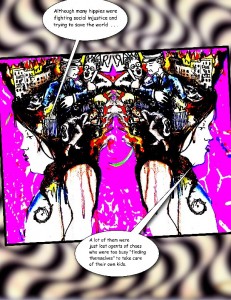 I think both writing and art are worth exploring. They have different qualities, for me visual art is a more physical and sensual experience — I’m creating with my hands and eyes — so it’s more visceral and immediate. It’s also very difficult and emotional. When I write, I am bringing in the narrator — the rational voice that explains the wild visuals. I need both. I think they inform and support each other. I get flack for this though. Several art teachers told me that I couldn’t call my work art because it’s too illustrative and relies to heavily on text. That’s another reason I called my book “That’s Not Art.” It’s something I’ve heard a lot.
I think both writing and art are worth exploring. They have different qualities, for me visual art is a more physical and sensual experience — I’m creating with my hands and eyes — so it’s more visceral and immediate. It’s also very difficult and emotional. When I write, I am bringing in the narrator — the rational voice that explains the wild visuals. I need both. I think they inform and support each other. I get flack for this though. Several art teachers told me that I couldn’t call my work art because it’s too illustrative and relies to heavily on text. That’s another reason I called my book “That’s Not Art.” It’s something I’ve heard a lot.
My students are often surprised by what they write. Are yours sometimes surprised by what they produce artistically?
Students are often surprised by what they can do. I teach a cartooning class to ten-year-olds and one of new my students said she couldn’t just draw the ideas she had in her head. I said every artist feels like that, she just needed some tools, techniques and lots of practice. She soaked up every lesson and worked super hard. Now she’s making her own comic books. My teaching partner Paul Ferrara and I ran a workshop for Lifetime Arts in fall 2010 at the Countee Cullen branch of the New York Public Library called LifeMaps. This class incorporated collage and maps into work about the students’ lives. The students were aged 55 and over and many had never made art before. At the end of the workshop, one student actually said, “I didn’t realize I could do this. It opens up new possibilities for me.”
Many of us, whether we’re visual artists, writers, musicians, or work in another art form, can relate to the theme of your film “My Life in Pictures,” which is conquering the self-doubt that often blocks creativity. Was there a pivotal moment in your life when you discovered that you had the ability, or drive — at least temporarily — to overcome self-doubt?
Yes, it was when I was in a sculpture class. I had gone back to school to get my bachelor’s degree and I hadn’t made art in 20 years. I was having an anxiety attack, when I realized I had no idea what I was doing — and that freed me! I was able to put my ego to the side and just open myself up to what this fantastic teacher, Jock Ireland, had to teach me. I realized how important humility is to the learning process. I think the Buddhists call it “beginner’s mind.”
What advice would you offer a beginner who would like to explore art – or really, anything creative — but has difficulty finding a way in, or lacks confidence?
Get started. Go for what interests you. Get a sketchbook and/or a camera and just start drawing and shooting everything that appeals to your eye. Do at least three images per day. Take a class at a community centre (like a library) and see what other people are doing in your chosen medium. Play with new methods and materials with the intention of learning, NOT making a masterpiece. Mistakes are how we learn, so make as many as you can. Go to movies, museums and galleries, and in your sketchbook reflect on what you’ve seen. Get out of your own way. Every time that voice tells you to stop, answer it by exploring new ideas and working on your craft.
I struggle every day, but as I said in my film, “Now I just keep drawing.”
* * *
Celia,
The following statement resonated with me, “No matter the age, every student wants to make something meaningful.” It’s overcoming self-doubt and fear of failure that locks out our potential. Until we try, we don’t know what we’re capable of creating. Your course holds the key for so many. Kudos to you for discovering your talent and sharing it with others. I’m doodling you a happy face.
Mary,
Thank you so much for your kind and insightful comments. Fear, self-doubt and shame hold too many of us back, but if we just “show up on the page” consistently, their power over us will diminish as our confidence and skills increase. Thanks for the happy face doodle too! Did you know doodling enhances creativity and memory? You might be interested in this Ted Talk from Sunni Brown: http://blog.ted.com/2011/09/23/doodlers-unite-sunni-brown-on-ted-com/
I’m so proud of you, Celia!!! Love the mini movie 🙂
Celia…I am amazed at the depth of your visual art and language arts blend. the richness and layers of complexity….